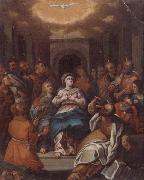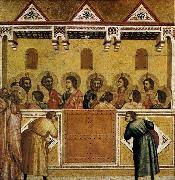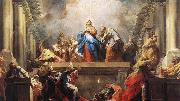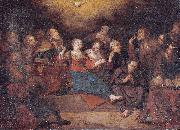Wholesale Oil Painting No Minimum |
|||||||||||
|
|
|||||||||||

|
|||||||||||
|
|
|
||||||||
|
|
||||||||
Pentecost
Pentecost Painting ID:: 27509 |
mk56
oil on copper
mk56 oil on copper |
|||||||
|
|
||||||||
GIOTTO di BondoneItalian Early Renaissance Painter, 1267-1337 Italian painter and designer. In his own time and place he had an unrivalled reputation as the best painter and as an innovator, superior to all his predecessors, and he became the first post-Classical artist whose fame extended beyond his lifetime and native city. This was partly the consequence of the rich literary culture of two of the cities where he worked, Padua and Florence. Writing on art in Florence was pioneered by gifted authors and, although not quite art criticism, it involved the comparison of local artists in terms of quality. The most famous single appreciation is found in Dante's verses (Purgatory x) of 1315 or earlier. Exemplifying the transience of fame, first with poets and manuscript illuminators, Dante then remarked that the fame of Cimabue, who had supposed himself to be the leader in painting, had now been displaced by Giotto. Ironically, this text was one factor that forestalled the similar eclipse of Giotto's fame, which was clearly implied by the poet. |
||||||||
|
|
||||||||
|
|
Pentecost
Pentecost Painting ID:: 44316 |
1320-25
Egg tempera on poplar,
46 x 44 cm 1320-25 Egg tempera on poplar, 46 x 44 cm |
||||||
|
|
||||||||
Jean RestoutFrench Neoclassical Painter, 1692-1768,was a French Neoclassical painter. Jean Restout was born in Rouen, the son of Jean Restout, the first of that name, and of Marie M. Jouvenet, sister and pupil of the then well-known Jean Jouvenet. In 1717, the Royal Academy having elected him a member on his work for the Grand Prix, he remained in Paris, instead of proceeding to Italy, exhibited at all the salons, and filled successively every post of academical distinction. His works, chiefly altar-pieces (Louvre Museum), ceilings and designs for Gobelin tapestries, were engraved by Cochin, Drevet and others; his diploma picture may still be seen at St Cloud. His son, Jean Bernard Restout (1732 - 1797), |
||||||||
|
|
||||||||
|
|
Pentecost
Pentecost Painting ID:: 52702 |
1732 Oil on canvas, 465 x 778 cm 1732 Oil on canvas, 465 x 778 cm |
||||||
|
|
||||||||
Salomon de Bray(Amsterdam, 1597 - Haarlem, 11 May 1664) was a Dutch Golden Age architect and painter. De Bray established himself in Haarlem before 1617, where he is registered as being a member of the schutterij that year in the St. Adrian's cloveniers.[1] He probably followed draftsmanship and painting lessons in the small academy started by Karel van Mander, Hendrick Goltzius and Cornelis van Haarlem, and where he married in 1625. He is registered as a pupil of Goltzius and Cornelis van Haarlem, but he probably started his training in Amsterdam with Jan Pynas, Nicolaes Moeyaert and Pieter Lastman.He painted history paintings, portraits and landscapes. As a Catholic he probably also made altar pieces for the Haarlem underground Catholic churches known as mission stations, or staties. He was a member of the Chamber of rhetoric called "De Wijngaertranken". This is probably how he met his wife Anna, the sister of the painter Jan and the poet Jacob Westerbaen. They married in 1625 and in 1630 he became a member of the Haarlem Guild of St. Luke. He cooperated with fellow Haarlem lukasguild member Jacob van Campen in the decoration of Huis ten Bosch in The Hague. His works draw on the spirit of the Dutch classicism beginning at that time, and are comparable with those of Pieter de Grebber. Transcription of Salomon de Bray's proposed hierarchy of the guild in 1631. The Haarlem archivist C.J. Gonnet published a book in 1877 on the Haarlem St. Lukasgilde archives. This was meant for historians wishing to do research on Haarlem painting, but who could not read the old handwriting.De Bray was also active as a designer of silverwork, as a poet, as an architect and as a town planner for the city council of Haarlem. He designed an ambitious plan to expand the city on the North side that was partially implemented in the decades after his death. He became headman of the Guild of St. Luke and even prepared a new charter for the guild (that was never ratified) in 1631. As an architect, he was involved in the construction or expansion of Haarlem's City Hall, Zijlpoort, and St. Annakerk (Church of St. Anne), and Nijmegen's city orphanage. One of his poems was set to music by his friend the composer Cornelis Padbru??. Salomon de Bray was the father of ten children, of whom three (Dirck de Bray, Jan de Bray, and Joseph de Bray) became notable artists. He probably died of the plague that hit Haarlem in 1664, as he and his children Jacob, Josef, Juliana and Margaretha all died in April and May of that year. His wife had already died the previous year. He was buried in the Sint-Bavokerk in Haarlem. In 1631 Salomon de Bray wrote "Architectura Moderna" which provided a biography and descriptions of buildings built by Hendrick de Keyser, one of the key Dutch architects of the period |
||||||||
|
|
||||||||
|
|
Pentecost
Pentecost Painting ID:: 97190 |
oil on panel
38.1 x 52.1 cm
signed b.c.: SBray. 1654
cyf oil on panel 38.1 x 52.1 cm signed b.c.: SBray. 1654 cyf |
||||||
|
|
||||||||
|
Salomon de Bray (Amsterdam, 1597 - Haarlem, 11 May 1664) was a Dutch Golden Age architect and painter. De Bray established himself in Haarlem before 1617, where he is registered as being a member of the schutterij that year in the St. Adrian's cloveniers.[1] He probably followed draftsmanship and painting lessons in the small academy started by Karel van Mander, Hendrick Goltzius and Cornelis van Haarlem, and where he married in 1625. He is registered as a pupil of Goltzius and Cornelis van Haarlem, but he probably started his training in Amsterdam with Jan Pynas, Nicolaes Moeyaert and Pieter Lastman.He painted history paintings, portraits and landscapes. As a Catholic he probably also made altar pieces for the Haarlem underground Catholic churches known as mission stations, or staties. He was a member of the Chamber of rhetoric called "De Wijngaertranken". This is probably how he met his wife Anna, the sister of the painter Jan and the poet Jacob Westerbaen. They married in 1625 and in 1630 he became a member of the Haarlem Guild of St. Luke. He cooperated with fellow Haarlem lukasguild member Jacob van Campen in the decoration of Huis ten Bosch in The Hague. His works draw on the spirit of the Dutch classicism beginning at that time, and are comparable with those of Pieter de Grebber. Transcription of Salomon de Bray's proposed hierarchy of the guild in 1631. The Haarlem archivist C.J. Gonnet published a book in 1877 on the Haarlem St. Lukasgilde archives. This was meant for historians wishing to do research on Haarlem painting, but who could not read the old handwriting.De Bray was also active as a designer of silverwork, as a poet, as an architect and as a town planner for the city council of Haarlem. He designed an ambitious plan to expand the city on the North side that was partially implemented in the decades after his death. He became headman of the Guild of St. Luke and even prepared a new charter for the guild (that was never ratified) in 1631. As an architect, he was involved in the construction or expansion of Haarlem's City Hall, Zijlpoort, and St. Annakerk (Church of St. Anne), and Nijmegen's city orphanage. One of his poems was set to music by his friend the composer Cornelis Padbru??. Salomon de Bray was the father of ten children, of whom three (Dirck de Bray, Jan de Bray, and Joseph de Bray) became notable artists. He probably died of the plague that hit Haarlem in 1664, as he and his children Jacob, Josef, Juliana and Margaretha all died in April and May of that year. His wife had already died the previous year. He was buried in the Sint-Bavokerk in Haarlem. In 1631 Salomon de Bray wrote "Architectura Moderna" which provided a biography and descriptions of buildings built by Hendrick de Keyser, one of the key Dutch architects of the period Pentecost oil on panel 38.1 x 52.1 cm signed b.c.: SBray. 1654 cyf |
||||||||
|
|
||||||||
|
Prev Next
|
||||||||
|
|
||||||||
|
Related Paintings to Salomon de Bray :. |
||||||||
|
|
||||||||
|
CONTACT US |




